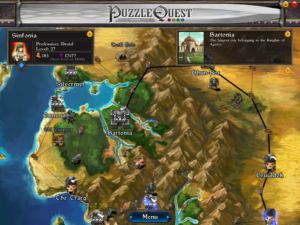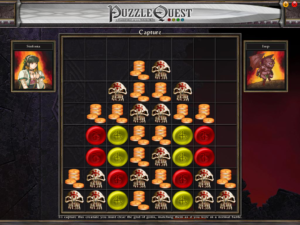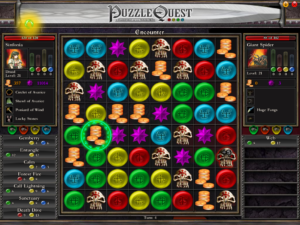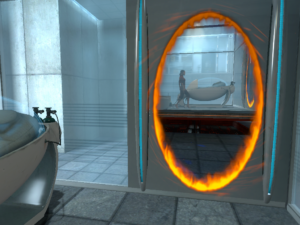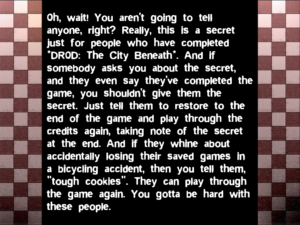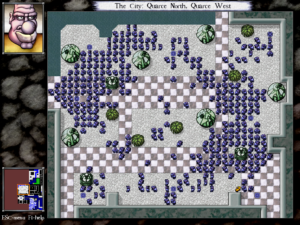Puzzle Quest: Spells
Combat in RPGs is always an abstraction. Even in a relatively concrete system like D&D, there’s a sense that the actions explicitly taken aren’t all that’s “really” going on: combat rounds are supposedly six seconds long, which is an awfully long time to make a single sword thrust. Combat in Puzzle Quest is of course a great deal more abstract than that, but it still makes me wonder how much can this be regarded as an abstract representation of combat.
It’s the spells that are really suggestive in this regard. I call them “spells” because the game does, but in a lot of cases “special attack” is more apt. For example, ogres have a “spell” called “Thump!” that simply does 10 points of damage. It’s not hard to imagine this as an action that the ogre performs, and the “red mana” that it needs in order to perform it as a matter of summoning up its strength.
Or consider the sandworm. The sandworm has a potent combination attack consisting of the spells Sinkhole, which doubles the target’s green mana while halving mana in all the other colors, and Swallow Whole, which is a direct damage spell that increases in strength with its target’s green mana (the color that Sinkhole just doubled). Now, the four colors of mana correspond to the four elements, with green being earth. So one can imagine how sinking into the ground would increase your access to earth magic while decreasing your access to any other kind. Swallow Whole is trickier to explain — does your contact with the earth enable the sandworm to swallow you more thoroughly or something?
The Haste spell is a particularly interesting case: While it lasts, it does 4 points of damage to the opponent whenever you get an extra turn. This isn’t at all what I’d expect a spell called Haste to do. I’d expect it to do something more like grant its caster extra turns. But there are other spells for that, such as Entangle and Petrify — things that emphasize immobility on the part of the opponent, not additional mobility on the part of the caster. What Haste does, though, is it gives the caster an extra motivation to take advantage of things that grant extra turns. So the end result is that casting Haste has haste as an indirect effect.
The most tactically interesting spells are the ones that alter things on the board. There’s a spell called Burn that turns all the green (earth) gems into red (fire), and another called Freeze that turns all the red gems into blue (water, the closest thing the game has to ice). Griffons have a spell called Soar that turns all the green and blue gems into yellow (air) — a pretty clear representation of moving the arena of combat away from the land and sea and into the sky. Spells like these, executed at the right time, immediately create multiple rows of 3 or more, which collapse and then cascade and probably yield extra turns.
Even more intriguing, though, are the spells that involve the board geometry, such as Besiege (a “spell” used by catapults, which destroys a random 3×3 section of the board and gets full effects for every gem in it), Call Lightning (destroy one column and get the full effects) and Charge! (destroy one selected row, get the full effects, and do 5 points of damage). These paradoxically work against any attempt at interpreting the action as an abstraction of combat by not being abstract enough. They’re over-literal, and rebuff any attempt to take them seriously. They’re also among my favorite spells in the game — Charge! in particular has all sorts of tactical uses.
 Comments(0)
Comments(0)